| City of Sydney New South Wales | |||||||||||||||
|---|---|---|---|---|---|---|---|---|---|---|---|---|---|---|---|
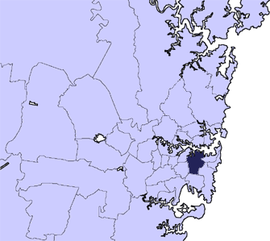 Location in Metropolitan Sydney Location in Metropolitan Sydney | |||||||||||||||
| Coordinates | 33°52′S 151°12′E / 33.867°S 151.200°E / -33.867; 151.200 | ||||||||||||||
| Population | 211,632 (2021 census) (17th) | ||||||||||||||
| • Density | 8,470/km (21,900/sq mi) | ||||||||||||||
| Established | 20 July 1842 | ||||||||||||||
| Area | 25 km (9.7 sq mi) | ||||||||||||||
| Time zone | AEST (UTC+10) | ||||||||||||||
| • Summer (DST) | AEDT (UTC+11) | ||||||||||||||
| Lord Mayor | Clover Moore | ||||||||||||||
| Council seat | Sydney CBD (Town Hall) | ||||||||||||||
| Region | Central Sydney | ||||||||||||||
| State electorate(s) | |||||||||||||||
| Federal division(s) | |||||||||||||||
| Website | City of Sydney | ||||||||||||||
| |||||||||||||||
The City of Sydney is the local government area covering the Sydney central business district and surrounding inner city suburbs of the Greater Sydney, New South Wales, Australia. Established by Act of Parliament in 1842, the City of Sydney is the oldest, and the oldest-surviving, local government authority in New South Wales, and the second-oldest in Australia, with only the City of Adelaide being older by two years.
Given its prominent position, historically, geographically, economically and socially, the City of Sydney has long been a source of political interest and intrigue. As a result of this, the boundaries, constitution and legal basis of the council have changed many times throughout its history, often to suit the governing party of the State of New South Wales. The City of Sydney is currently governed under the City of Sydney Act, 1988, which defines and limits the powers, election method, constitution and boundaries of the council area. On 6 February 2004, the former local government area of the City of South Sydney, which itself had been created in 1989 from areas formerly part of the City of Sydney (including Alexandria, Darlington, Erskineville, Newtown and Redfern), was formally merged into the City of Sydney and the current city boundaries date from this merger.
The leader of the City of Sydney is known as the Lord Mayor of Sydney, currently held since 27 March 2004 by Clover Moore, who also served concurrently as the state Member of Parliament for Sydney and Bligh from 1988 to 2012.
Suburbs and localities in the local government area
Suburbs within or partially within the City of Sydney are:
- Alexandria
- Annandale (shared with Inner West Council)
- Barangaroo
- Beaconsfield
- Camperdown (shared with Inner West Council)
- Centennial Park (shared with City of Randwick)
- Chippendale
- Darlinghurst
- Darlington
- Dawes Point
- Elizabeth Bay
- Erskineville
- Eveleigh
- Forest Lodge
- Glebe
- Haymarket
- Millers Point
- Moore Park
- Newtown (shared with Inner West Council)
- Paddington (shared with Municipality of Woollahra)
- Potts Point
- Pyrmont
- Redfern
- Rosebery (shared with Bayside Council)
- Rushcutters Bay
- St Peters (shared with Inner West Council)
- Surry Hills
- Sydney CBD
- The Rocks
- Ultimo
- Waterloo
- Woolloomooloo
- Zetland
Localities in the City of Sydney are:
- Broadway
- Central
- Central Park
- Chinatown
- Circular Quay
- Darling Harbour
- The Domain
- East Sydney
- Garden Island
- Goat Island
- Golden Grove
- Green Square
- Kings Cross
- Macdonaldtown
- Railway Square
- Strawberry Hills
- St James
- Wynyard
Urban places:
The Geographical Names Board of New South Wales defines an urban place as a place, site or precinct in an urban landscape, the name of which is in current use, but the limits of which have not been defined under the address locality program.
- Argyle Cut
- Centennial Parklands Entertainment Quarter
- Central
- Chinatown
- Church Hill
- Circular Quay
- Darling Island
- Darling Square
- East Sydney
- Equality Green
- Fox Studios
- Gallows Hill
- Glebe Point
- Golden Grove
- Herald Square
- Jack Mundey Place
- Kings Cross
- Macdonaldtown
- Queens Square
- Shakespeare Place
- Strawberry Hills
- Taylor Square
- The Hungry Mile
- The University of Sydney
- Three Saints Square
- Town Hall
- Walsh Bay
- Wynyard
History
See also: Coat of arms of Sydney and Flag of the City of Sydney
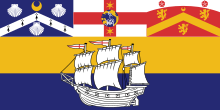
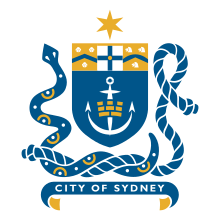

The name Sydney comes from "Sydney Cove" which is where the English Governor (later Admiral) Arthur Phillip established the first settlement, after arriving with the First Fleet. On 26 January 1788, he named it after Thomas Townshend, 1st Viscount Sydney, who was the Home Secretary at the time, and the man responsible for the plan for the convict colony in Australia.
The "City of Sydney" was established on 20 July 1842 by the Corporation Act which encompasses present-day Woolloomooloo, Surry Hills, Chippendale and Pyrmont, an area of 11.65 km. There were six wards established by boundary posts. These wards were: Gipps, Brisbane, Macquarie, Bourke, Cook and Phillip. A boundary post still exists in front of Sydney Square.
The boundaries of the City of Sydney have changed fairly regularly since 1900. The bankrupt Municipality of Camperdown was merged with the city in 1909. As a result of the Local Government (Areas) Act 1948, the municipalities of Alexandria, Darlington, Erskineville, Newtown, Redfern, The Glebe, Waterloo, and Paddington were added to the city. In 1968 the boundaries were changed and many of these suburbs moved to be part of a new municipality of South Sydney. South Sydney was brought back into the city in 1982, but became separate again under the City of Sydney Act of 1988 and then became smaller than its original size at 6.19 km. It grew again in February 2004 with the merger of the two council areas, and now has a population of approximately 170,000 people.
These changes in boundaries have often resulted in control of the council by the governing party in the Parliament of New South Wales at the time; the Labor Party often sought to have traditional working-class suburbs like Redfern, Erskineville, Alexandria and Waterloo included in the council area, and the Liberal Party and its predecessors often desired a smaller council area focused on inner-Sydney or a limited/broader voting franchise. A 1987 re-organisation initiated by a Labor state government and completed in 1989 under a Liberal Coalition government saw the City of Sydney split again, with southern suburbs forming the City of South Sydney, a moved that advantaged the government of the day, as the southern suburbs now in South Sydney Council had traditionally voted Labor.
On 8 May 2003 the Labor state Government partially undid this change, when approximately 40% of the South Sydney City Council area was merged back into the City of Sydney including Camperdown, Chippendale, Darlington, East Sydney, Kings Cross and Woolloomooloo. Glebe was also transferred back from Leichhardt Council to the City of Sydney. On 6 February 2004, the remaining parts of the South Sydney City Council were merged into the City of Sydney. Critics claimed that this was performed with the intention of creating a "super-council" which would be under the control of Labor, which also controlled the NSW Government. Subsequent to this merger, an election took place on 27 March 2004 which resulted in the independent candidate Clover Moore defeating the high-profile Labor candidate, former federal minister Michael Lee and winning the position of Lord Mayor.
Boundary
The current City of Sydney Local Government Area (LGA) covers about 26.15 square kilometres (281,500,000 sq ft).
City of Sydney provides an official map of the LGA. Alternatively the Geographical Names Board of New South Wales provides an interactive map of the Sydney LGA.
Historical Boundaries
The City of Sydney is traditionally the governing authority for Sydney's city centre. However, the boundaries of the City of Sydney have always been larger than the city centre or CBD. For example, Pyrmont has been in the City of Sydney since 1842 but is usually considered to be an inner western suburb, not a part of the Sydney city centre or CBD.
-
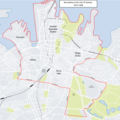 Boundaries pre–1909
Boundaries pre–1909
-
 Boundaries 1909–1948
Boundaries 1909–1948
-
 Boundaries 1949–1968
Boundaries 1949–1968
-
 Boundaries 1968–1982
Boundaries 1968–1982
-
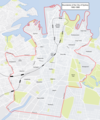 Boundaries 1982–1988
Boundaries 1982–1988
-
 Boundaries 1989–2003
Boundaries 1989–2003
The postcode zone 2000 is also roughly correlative with the city centre.
Demographics
At the 2021 census, there were 211,632 people in the Sydney local government area, of these 52.3% were male and 47.7% were female. Aboriginal and Torres Strait Islander people made up 1.4% of the population. The median age of people in the City of Sydney was 34 years. Children aged 0 – 14 years made up 7.6% of the population and people aged 65 years and over made up 9.7% of the population. Of people in the area aged 15 years and over, 25.2% were married and 9.8% were either divorced or separated.
Population growth in the City of Sydney between the 2006 Census and the 2011 Census was 4.57%; with a significant increase of 22.93% between 2011 and 2016; and a more modest increase of 1.56% between 2016 and 2021 likely as a result of the COVID-19 pandemic. When compared with total population growth of Australia of 8.81% between 2011 and 2016, population growth in the Sydney local government area was almost triple the national average. The median weekly income for residents within the City of Sydney was just under 1.5 times the national average.
The proportion of dwellings in the City of Sydney that are apartments or units is 78.5%, which is substantially different from the Australian average of 14.2%. The proportion of residents in the Sydney local government area that claimed Australian ancestry was approximately half the national average.
| Selected historical census data for Sydney local government area | |||||||
|---|---|---|---|---|---|---|---|
| Census year | 2001 | 2006 | 2011 | 2016 | 2021 | ||
| Population | Estimated residents on census night | 137,641 | 156,571 | 169,505 | 208,374 | 211,632 | |
| LGA rank in terms of size within New South Wales | 10th | ||||||
| % of New South Wales population | 2.18% | ||||||
| % of Australian population | |||||||
| Estimated ATSI population on census night | 1,993 | ||||||
| % of ATSI population to residents | 1.4% | ||||||
| Median weekly incomes | |||||||
| Personal income | Median weekly personal income | A$717 | A$888 | A$953 | $A1,241 | ||
| % of Australian median income | 153.9% | ||||||
| Family income | Median weekly family income | A$1,204 | A$2,273 | $A2,524 | $A3,057 | ||
| % of Australian median income | 117.2% | ||||||
| Household income | Median weekly household income | A$1,819 | A$1,639 | A$1,926 | A$2,212 | ||
| % of Australian median income | 105.9% | ||||||
| Dwelling structure | |||||||
| Dwelling type | Flat or apartment | 61.6% | |||||
| Semi-detached, terrace or townhouse | 22.9% | ||||||
| Separate house | 2.8% | ||||||
| Other dwellings | 1.5% | ||||||
| Unoccupied dwellings | 10.2% | ||||||
| Selected historical census data for Sydney local government area | |||||||||
|---|---|---|---|---|---|---|---|---|---|
| Ancestry, top responses | |||||||||
| 2001 | 2006 | 2011 | 2016 | 2021 | |||||
| No Data | No Data | English | 19.3% | English | English | 25.1% | |||
| Australian | 13.9% | Chinese | Australian | 16.8% | |||||
| Chinese | 9.7% | Australian | Chinese | 16.8% | |||||
| Irish | 8.5% | Irish | Irish | 10.7% | |||||
| Scottish | 5.8% | Scottish | Scottish | 7.5% | |||||
| Country of Birth, top responses | |||||||||
| 2001 | 2006 | 2011 | 2016 | 2021 | |||||
| Australia | 41.1% | Australia | Australia | Australia | Australia | ||||
| United Kingdom | 5.0% | England | China | China | China | ||||
| New Zealand | 3.5% | China | England | England | England | ||||
| China | 2.2% | New Zealand | New Zealand | Thailand | Thailand | ||||
| Indonesia | 1.9% | Indonesia | Indonesia | New Zealand | Indonesia | ||||
| Hong Kong | 1.0% | South Korea | Thailand | Indonesia | New Zealand | ||||
| Language, top responses (other than English) | |||||||||
| 2001 | 2006 | 2011 | 2016 | 2021 | |||||
| Cantonese | 2.9% | Mandarin | Mandarin | Mandarin | Mandarin | ||||
| Mandarin | 2.2% | Cantonese | Cantonese | Thai | Cantonese | ||||
| Indonesian | 1.6% | Indonesian | Thai | Cantonese | Thai | ||||
| Greek | 1.5% | Korean | Indonesian | Indonesian | Spanish | ||||
| Russian | 1.2% | Greek | Korean | Spanish | Indonesian | ||||
| Religious affiliation, top responses | |||||||||
| 2001 | 2006 | 2011 | 2016 | 2021 | |||||
| No Religion | 19.0% | No Religion | No Religion | No Religion | No Religion | ||||
| Catholic | 18.4% | Catholic | Catholic | Not Stated | 15.8% | Catholic | |||
| Anglican | 11.1% | Anglican | Anglican | Catholic | Not Stated | 8.4% | |||
| Buddhism | 4.2% | Buddhism | Buddhism | Buddhism | Buddhism | ||||
| Eastern Orthodox | 2.7% | Eastern Orthodox | Eastern Orthodox | Anglican | Anglican | ||||
- ^a 2001 Census data comprise the sum of the former South Sydney and the former Sydney local government areas with the addition of localities Glebe and Forest Lodge.
Council
See also: List of mayors, lord mayors and administrators of Sydney| City of Sydney Council | |
|---|---|
| Leadership | |
| Lord Mayor | Clover Moore (Team Clover) |
| Deputy Lord Mayor | Zann Maxwell (Labor) |
| Chief Executive Officer | Monica Barone |
| Structure | |
| Seats | 10 including the Lord Mayor |
| Political groups |
|
| Elections | |
| Voting system | Single transferable vote |
| Last election | 14 September 2024 |
| Next election | 16 September 2028 |
| Meeting place | |
 | |
| The Sydney Town Hall, seat of the City Council | |
Current Composition & Election Method
Sydney City Council is composed of ten Councillors, including the Lord Mayor, for a fixed four-year term of office. The Lord Mayor is directly elected while the nine other Councillors are elected proportionally. The Deputy Lord Mayor is elected annually by the councillors.
The most recent election was held on 14 September 2024, and the makeup of the council, including the Lord Mayor, is as follows:
| Party | Councillors | |
|---|---|---|
| Clover Moore Independent Team | 4 | |
| Australian Labor Party | 2 | |
| The Greens | 2 | |
| Liberal Party of Australia | 1 | |
| Independent | 1 | |
| Total | 10 | |
The current Council, elected in 2024, in order of election, is:
| Lord Mayor | Party | Notes | |
|---|---|---|---|
| Clover Moore | Clover Moore Independents | Lord Mayor, 2004–present. MP for Sydney and Bligh 1988–2012. | |
| Councillor | Party | Notes | |
| Zann Maxwell | Labor | Deputy Lord Mayor, 2024–present. | |
| Lyndon Gannon | Liberal | ||
| Sylvie Ellsmore | Greens | Marrickville Council Councillor, 2012–2016; Deputy Lord Mayor, 2022–2023. | |
| Robert Kok | Clover Moore Independents | Elected 2008; Deputy Lord Mayor, 2011–2012, 2023–2024 | |
| Jess Miller | Clover Moore Independents | ||
| Adam Worling | Clover Moore Independents | ||
| Mitch Wilson | Labor | ||
| Yvonne Weldon | Independent | ||
| Matthew Thompson | Greens | ||
Business vote
Unlike all other local government area in NSW (which are governed under the Local Government Act, 1993), the City of Sydney is governed under the City of Sydney Act, 1988. On 25 September 2014, the NSW Liberal/National Coalition Government of Mike Baird, in conjunction with the Shooters and Fishers Party in the Legislative Council, passed the City of Sydney Amendment (Elections) Act, 2014, which allowed businesses to have two votes each in City of Sydney elections via a compulsory non-resident register that is maintained at the expense of the City Council.
Implemented for the 2016 election and maintained by Council at an annual cost of $1.7 million, the additional business roll was widely criticised as being an infringement on the democratic process and an attempt to gerrymander election results by the Liberal/National Coalition. At the time of the bill ABC election analyst, Antony Green, noted: "For eight decades both sides of NSW politics have viewed Sydney's Lord Mayoralty as a bauble to be delivered as soon as possible to someone that the new government thinks is right and proper to hold the position Given the history ... it is a little difficult to view the proposed changes as anything other than being a state government trying again to get its way on who should be Lord Mayor of Sydney."
The Lord Mayor Clover Moore also expressed her opposition, seeing it as another attempt to attack her administration and that the new compulsory business register "placed an unworkable and costly burden on the council One of the great flaws of the legislation was that it gives businesses two votes and residents just one, completely reversing one of the founding principles of Australia’s democracy: one vote, one value. was not about business voting at all – it was about manipulating democracy." Moore's position has been supported by several community groups and also Labor Councillor and President of Local Government NSW, Linda Scott, who expressed her view that the business vote is "complex, costly and has no clear public benefit." However, one supporter of the business vote was former councillor Angela Vithoulkas: "Businesses and property owners pay over 72% of the rates , they deserve to have a voice and exercise their democratic right." Following the 2021 council elections, the NSW Electoral Commission issued 18,501 failure to vote notices and fines to non-residential electors in the City of Sydney, representing 39% of all non-residential electors for the area.
On 13 September 2023, Ron Hoenig, the Minister for Local Government in the new Labor state government of Chris Minns, announced that the government had introduced the City of Sydney Amendment Bill 2023 and planned to be implemented at the next elections scheduled for September 2024, that would reverse the 2014 amendment act and remove the compulsory double business voting roll, and return to the system of optional single business voting. On this announcement Hoenig commented: "The amendments were made by the Liberals in a brazen attempt to oust Sydney Lord Mayor Clover Moore from office and give the party an electoral advantage in controlling the Sydney Town Hall. As expected, the amendments have clearly missed their target with thousands of non-resident ratepayers being slugged with fines for not voting instead. For nearly a decade, City of Sydney ratepayers have also been forced to foot an annual bill of approximately $1 million to maintain the non-residential electoral roll. Nowhere else in this state do we see one group of voters favoured in this way. It erodes the democratic process and undermines the vital importance of giving residents and ratepayers a balanced voice in local council elections." The City of Sydney Amendment Act 2023 passed the Parliament on 21 September, and received royal assent from the Governor on 27 September 2023, returning to the optional single business vote in city elections.
Policies, services and initiatives
Environment
Further information: Climate change in AustraliaThe City of Sydney has adopted various policies to reduce the council's climate impact, including strategies implemented since the 2000s to reduce car pollution by investing in mass and public transit and introducing a fleet of 10 new Nissan Leaf electric cars, the largest order of the vehicle in Australia. The council has also invested in bicycle infrastructure, and cycling trips have increased by 113% across Sydney's inner-city since March 2010, with approximately 2,000 bikes passing through top peak-hour intersections on an average weekday.
The City of Sydney became the first council in Australia to achieve formal certification as carbon-neutral in 2008. The city has reduced its 2007 carbon emissions by 6% and since 2006 has reduced carbon emissions from city buildings by up to 20%. In 2008, the council adopted the Sustainable Sydney 2030 programme, which outlined various energy targets, such as a comprehensive plan to reduce energy in homes and offices within Sydney by 30%. In the commercial space, reductions in energy consumption have decreased energy bills by $30 million a year in more than half of office spaces, and solar panels] have been installed on many CBD buildings in an effort to minimise carbon pollution by around 3,000 tonnes a year. Sydney has become a leader in the development of green office buildings and enforcing the requirement of all building proposals to be energy-efficient.
The One Central Park development, completed in 2013, is an example of this implementation and design. Proposals to make all of Sydney's future buildings sustainable and environmentally friendly by using recycled water, rooftop gardens, efficient and renewable energy.
Sydney Peace Prize
The City of Sydney is a major supporter of the Sydney Peace Prize.
Libraries
Main article: City of Sydney LibrarySister cities
Sydney City Council maintains sister city relations with the following cities:
 San Francisco, California, United States, since 1968
San Francisco, California, United States, since 1968 Nagoya, Japan, since 1980
Nagoya, Japan, since 1980 Wellington, New Zealand, since 1982
Wellington, New Zealand, since 1982 Portsmouth, England, since 1984
Portsmouth, England, since 1984 Guangzhou, China, since 1986
Guangzhou, China, since 1986 Florence, Tuscany, Italy, since 1986
Florence, Tuscany, Italy, since 1986
Friendship cities
 Paris, France, since 1998
Paris, France, since 1998 Berlin, Germany, since 2000
Berlin, Germany, since 2000 Athens, Greece, since 2000
Athens, Greece, since 2000 Dublin, Ireland, since 2002
Dublin, Ireland, since 2002 Chicago, Illinois, United States, since 21 February 2019 (The City of Sydney considers the City of Chicago a "friendship city", while the City of Chicago considers the City of Sydney a "sister city.")
Chicago, Illinois, United States, since 21 February 2019 (The City of Sydney considers the City of Chicago a "friendship city", while the City of Chicago considers the City of Sydney a "sister city.") Wuhan, China, since 2014
Wuhan, China, since 2014
References
- ^ Australian Bureau of Statistics (28 June 2022). "Sydney (C)". 2021 Census QuickStats. Retrieved 26 June 2023.

- "Regional population, 2019-20 financial year | Australian Bureau of Statistics". 29 November 2021.
- "Areas of Service:Urban places". City of Sydney.
- "History of Sydney City Council" (PDF). City of Sydney. Archived from the original (PDF) on 3 December 2012. Retrieved 9 February 2007.
- ^ Green, Antony (5 September 2014). "NSW Parliament looks to stack Sydney City Council - again!". Antony Green's Election Blog - ABC Elections. Retrieved 23 May 2018.
- Dias, Avani (7 September 2017). "Cabinet papers reveal 1987 decision to sack Sydney council just as Clover Moore set to run for mayor". ABC News. Retrieved 23 May 2018.
- "Historic Council Boundaries". City of Sydney Data Hub. City of Sydney. Retrieved 5 December 2020.
- "Areas of service". City of Sydney.
- "Map of City of Sydney Local Government Area" (PDF). City of Sydney.
- ^ Australian Bureau of Statistics (27 June 2017). "Sydney (C)". 2016 Census QuickStats. Retrieved 30 June 2017.

- ^ Australian Bureau of Statistics (31 October 2012). "Sydney (C)". 2011 Census QuickStats. Retrieved 30 June 2017.

- ^ Australian Bureau of Statistics (9 March 2006). "Sydney (C)". 2001 Census QuickStats. Retrieved 11 November 2012.

- Australian Bureau of Statistics (9 March 2006). "South Sydney (C)". 2001 Census QuickStats. Retrieved 11 November 2012.

- ^ Australian Bureau of Statistics (25 October 2007). "Sydney (C)". 2006 Census QuickStats. Retrieved 11 November 2012.
- "City of Sydney - Elections". vtr.elections.nsw.gov.au. Retrieved 24 October 2024.
- "City of Sydney - Mayoral Election results". vtr.elections.nsw.gov.au. Retrieved 24 October 2024.
- "City of Sydney". vtr.elections.nsw.gov.au. Retrieved 24 October 2024.
- "Ms Clover Moore (1945- )". Members of the Parliament of New South Wales. Retrieved 23 May 2018.
- Visentin, Lisa; Robertson, James (11 September 2016). "Clover Moore wins record fourth term as Sydney lord mayor". Sydney Morning Herald. Retrieved 23 May 2018.
- "Meet the City of Sydney's new councillors" (Media Release). City of Sydney. 23 December 2021. Retrieved 25 December 2021.
- Sydney, City of. "Hear ye, hear ye! Your new City of Sydney Council | City of Sydney - News". news.cityofsydney.nsw.gov.au. Retrieved 24 October 2024.
- "City of Sydney Amendment (Elections) Act 2014 No 50". Legislation NSW. NSW Government. Retrieved 6 November 2021.
- Osborne-Crowley, Lucia (11 September 2014). "A history of the business vote". City Hub Sydney. Retrieved 6 November 2021.
- "Register to vote as a non-resident property owner, occupier or rate-paying lessee". City of Sydney. 3 November 2021. Retrieved 6 November 2021.
- ^ O'Sullivan, Matt (12 July 2021). "Cost to ratepayers of businesses voting in City of Sydney election nears $13m". Brisbane Times. Retrieved 6 November 2021.
- Bastians, Kate (10 June 2016). "City of Sydney election: Doubling businesses' votes favours Liberals- political analyst". Wentworth Courier. Retrieved 6 November 2021.
- Thomsen, Simon (13 August 2014). "NSW Government Plans To Give Business 2 Votes Each In City Of Sydney Council Elections". Business Insider Australia. Archived from the original on 15 August 2014. Retrieved 6 November 2021.
- Raue, Ben (5 September 2016). "City of Sydney council election: business vote the latest battleground in long war". The Guardian. Retrieved 6 November 2021.
- Chuter, Andrew (1 November 2021). "Residents push for an end to rigged City of Sydney vote". Green Left. Retrieved 6 November 2021.
- Green, Antony (5 September 2014). "NSW Parliament looks to stack Sydney City Council - again!". ABC News - Antony Green's Election Blog. Australian Broadcasting Corporation. Retrieved 6 November 2021.
- Simos, Andriana (27 September 2021). "'Make your voice heard': Angela Vithoulkas on business vote in council elections". The Greek Herald. Retrieved 6 November 2021.
- ^ Hoenig, Ron (13 September 2023). "Fairer democratic elections to return for City of Sydney" (Media Release). Office of Local Government NSW. Retrieved 20 September 2023.
- "'North Korea would be proud': Labor to unwind Coalition 'get Clover' laws". Sydney Morning Herald. 31 May 2023. Retrieved 20 September 2023.
- "City of Sydney Amendment Act 2023 No 27". legislation.nsw.gov.au. NSW Government. Retrieved 16 October 2023.
- "Buses and the Environment". State Transit Authority. Retrieved 3 February 2015.
- "City clears the way on pollution-free car fleet". sydneymedia.com.au. 13 February 2013. Archived from the original on 4 May 2013. Retrieved 3 February 2015.
- ^ "Achievements – City of Sydney". cityofsydney.nsw.gov.au. Retrieved 3 February 2015.
- "Sydney Water to become carbon neutral". The Age. 19 July 2007. Retrieved 3 February 2015.
- "Sydney Becomes Australia's First Carbon-Neutral Government Body". treehugger.com. 5 September 2008. Retrieved 3 February 2015.
- "It's official: Sydney is first carbon-neutral council". SydneyMedia.com.au. 9 November 2011. Retrieved 3 February 2015.
- "Building owners applaud city's ambitious master plan". climatecontrolnews.com.au. 25 February 2015. Retrieved 18 March 2015.
- "Sydney businesses cotton on: climate change action is good for the bottom line". The Guardian (UK). 18 March 2015. Retrieved 19 March 2015.
- "City of Sydney extends solar roll out to historic Rocks". RenewEconomy.com. 16 June 2014. Retrieved 3 February 2015.
- "'Greenest' Sydney building using rainforest timber". Sydney Morning Herald. 27 July 2011. Retrieved 3 February 2015.
- "One Central Park Gardens". Frasers Property. Archived from the original on 23 September 2013. Retrieved 3 February 2015.
- "Central Park Sydney – Architecture". Frasers Property. Archived from the original on 5 October 2013. Retrieved 3 February 2015.
- "Sydney Central Park project shows sustainable living". Australian Financial Review. 28 November 2013. Retrieved 3 February 2015.
- "Sister cities: City of Sydney". 22 February 2019. Retrieved 23 February 2019.
- "Joint Sister Cities Declaration" (PDF). City of Sydney. 21 February 2019. Archived (PDF) from the original on 31 March 2021. Retrieved 31 March 2021.
Based on the City of Sydney's guidelines for sister city relationships, the City of Chicago will be considered a "friendship city." Based on the City of Chicago's guidelines for sister city relationships, the City of Sydney will be considered a "sister city."
- 武汉国际友好城市一览表 [List of sister cities of Wuhan]. www.whfao.gov.cn(Foreign Affairs Office of Wuhan Municipal Government). Archived from the original on 13 April 2018. Retrieved 7 September 2018.
External links
- Official website for the City of Sydney
- Official tourism site for the City of Sydney
 City of Sydney travel guide from Wikivoyage
City of Sydney travel guide from Wikivoyage
| Sydney City Council elections | |
|---|---|
|
| Former wards of Sydney | |
|---|---|
| Local government areas of New South Wales | |||||||
|---|---|---|---|---|---|---|---|
| Metropolitan Sydney |
| ||||||
| Mid North Coast | |||||||
| Murray | |||||||
| Murrumbidgee | |||||||
| Hunter | |||||||
| Illawarra | |||||||
| Richmond Tweed | |||||||
| Southeastern | |||||||
| Northern | |||||||
| Central West | |||||||
| North Western | |||||||
| Far West | |||||||
| External territories | |||||||
| NSW Local government areas abolished or expanded by the NSW Local Government (Areas) Act 1948 | |
|---|---|
| Councils expanded | |
| Councils abolished | |